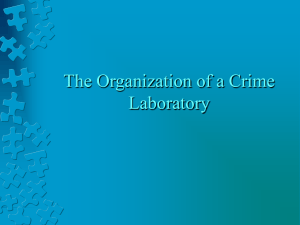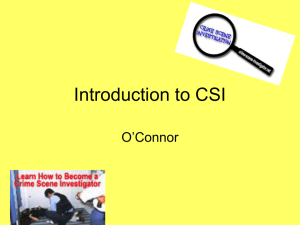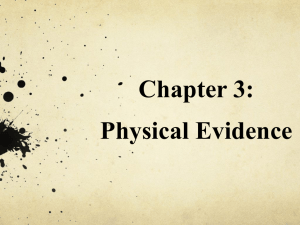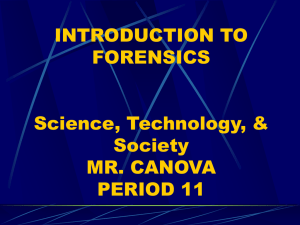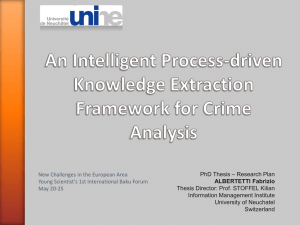Use of Forensic Sciences in Police Investigation
advertisement
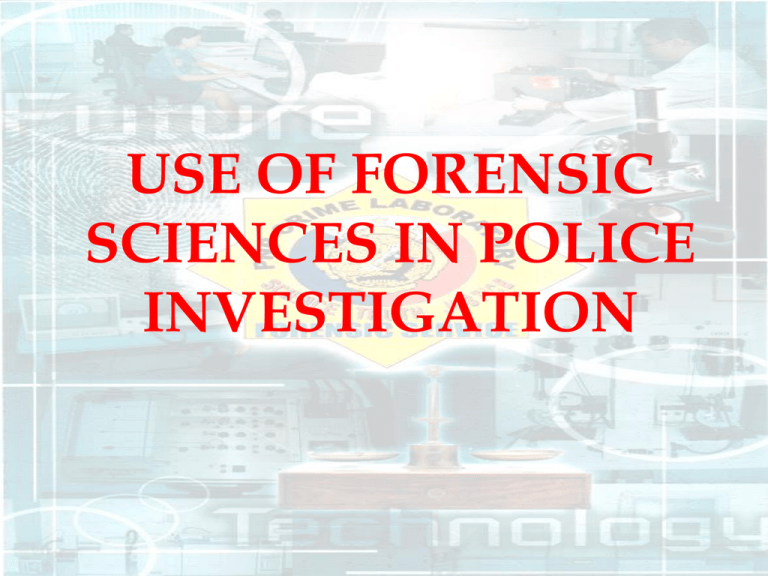
USE OF FORENSIC SCIENCES IN POLICE INVESTIGATION ORDER OF PRESENTATION History Mission Vision Core Competencies Capabilities and Functions The Evidence and its Use SOCO Flow Chart SOCO Video Presentation HISTORY OF CRIME LABORATORY The PNP Crime Laboratory was first organized as a Fingerprint Section of the G-2 Division of the Military Police Command Armed Forces in the West Pacific of the United States Army (AFWESPAC) in May 19, 1945. It was upgraded into a branch and was renamed as Crime Laboratory Branch of the Criminal Investigation Service, which was the investigative arm of the Philippine Constabulary (PC). The laboratory underwent several reorganizations and changes of names. It was reorganized on May 26, 1959 as a separate unit of the PC under Table of Organization and Equipment 3-07 (TO & E 3-07) of the Armed Forces of the Philippines and was renamed as PC Forensic Laboratory. On December 1, 1960, pursuant TO & E 03, the unit was renamed as the PC Central Crime Laboratory, and on June 28, 1961, it was activated as a unit of the Armed Forces of the Philippines pursuant to Special Order Number 453 GHQ AFP. The National Headquarters of the Crime Laboratory in Camp Crame was constructed during the term of then Philippine Constabulary Brigadier General Vicente Raval on December 4, 1968. The construction was completed on July 22, 1969, coinciding with its official designation as the PC Crime Laboratory (PCCL) pursuant to Headquarters Philippine Constabulary General Order Number 23. The crime laboratory saw continuous improvement in the following years in order to serve the people more effectively. In 1975, scientific pieces of equipment were acquired through the War Reparations Program of the Japanese Government. Organizationally, the crime laboratory was expanded in 1978, under the authority of HPC GO Nr 23 wherein twelve (12) regional units were established. With the merging of the Philippine Constabulary and the Integrated National Police (INP) on May 16, 1985, PCCL was re-designated as PC/INP Crime Laboratory Service (CLS) as per HPC GO Nr 64. By virtue of Republic Act 6975 (DILG) enacted in 1990, the PC/INP was abolished, paving way to the creation of the Philippine National Police. Consequently, the PNP Crime Laboratory Service was established as an Administrative Support Unit on January 30, 1990. In 1996, NAPOLCOM Resolution Nr 96-058 spelled out the streamlining program of the PNP and designated the PNPCLS as a National Operational Support Unit. Likewise, it dropped the word Service from the crime laboratory’s name and would simply be known as the PNP Crime Laboratory. MISSION To provide scientific method of investigation and technical support to the PNP and other government/nongovernment investigative agencies through fieldwork, scene of crime operation, forensic laboratory service, criminalistics training and research. VISION The men and women of the PNP Crime Laboratory are committed to the vision of a professional, dynamic and motivated forensic service, providing quality scientific investigation and working in partnership with responsive pillars of the Criminal Justice System towards the attainment of equality and justice. CORE COMPETENCIES BIOLOGICAL SCIENCE FORENSIC PHOTOGRAPHY POLYGRAPH EXAM QUESTIONED DOCUMENT EXAM PHYSICAL SCIENCE PNP CL PHYSICAL IDENTIFICATION FIREARMS IDENTIFCATION FINGERPRINT IDENTICATION CHEMISTRY DIVISION Conduct Qualitative aation of Dangerous Drugs under RA 9165 as well as volatile substances under PD 1619. Conduct examination of explosives and/or explosive ingredients. (PD 1866) Conduct examination of Firearms and Paraffin casts for the presence of Gunpowder Nitrates. Conduct Chemico-Toxicological examination of human internal organs, gastric contents, blood water and food sample and other substances. Conduct examination of fake products in case of unfair trade competition. (fundador, cement, SMB, cigarette, chlorox) Conduct blood alcohol determination. Examine urine and other body fluids for the presence of dangerous drugs. Conduct researches and training related to the cases being examined. Give lectures on Forensic Chemistry and Toxicology to various schools, universities, police training centers and other investigative units. Testify and give expert opinion in court. Respond to queries of all investigative units and render expert opinion regarding matters related to the application of chemical principles for the purpose of assisting investigators in developing investigative leads. Conduct Field laboratory work and clandestine laboratory investigationnd Quantitative Examin. PNP Forensic Explosives Laboratory Capabilities: The PNP Forensic Explosives Laboratory can determine the presence of different ions found in post blast debris and suspected explosive materials as well as other ions of potential forensic significance. The PNP Forensic Explosives Laboratory was created thru Philippines-Australia Counter Terrorism Capacity Building Project with the active support of the Australian Federal Police. The support includes laboratory set-up, equipment, supplies and training packages. Inaugurated on February 01, 2007 with the Australian Ambassador to the Philippines His Excellency Tony Hely as the guest of Honor and Speaker. MEDICO LEGAL DIVISION FUNCTIONS THE MISSION, CONDUCT EXAMINATIONS ON PERSONS INVOLVED IN PHYSICAL INJURY CASES AND SEXUAL OFFENSES. CONDUCT AUTOPSIES, EXHUMATIONS, SKELETAL AND ODONTOLOGICAL EXAMINATIONS TO DETERMINE THE CAUSE OF DEATH AND IDENTITY OF PERSONS. CONDUCT HISTOPATHOLOGICAL AND SEROLOGICAL EXAMINATIONS TO DETERMINE EXACT CAUSE OF DEATH AS WELL AS THE PRESENCE AND TYPE OF HUMAN BLOOD. CONDUCT DNA ANALYSIS FOR PERSON IDENTIFICATION. CONDUCT LECTURES TO DIFFERENT POLICE/ MILITARY INSTITUTIONS, GOVERNMENT AGENCIES AND PRIVATE / PUBLIC SCHOOLS. ORIENT AND TRAIN NEW PERSONNEL AND OJT ON FUNCTIONS AND CAPABILITIES ON THE DIVISION. DNA BRANCH, MEDICO LEGAL DIVISION FUNCTION AND CAPABILITIES 1. PROVIDES FORENSIC DNA FINGERPRINTING/ANALYSIS TO MATCH THE SUSPECT OF THE CRIME IN CASES OF: A. Alleged raped and other sexual crimes wherein biological sample are recovered B. Alleged murder/ homicide to established identity of perpetrator C. Found dead bodies where standard manner of identification could not establish identity 2. Identifies Victims of Mass Disasters such as in: A. Plane Crashes B. Ship wreckage C. Fire Disasters 3. Establishes paternity/Maternity in child custody conflict and inheritance lawsuits to link consanguinity PHYSICAL IDENTIFICATION DIVISION Capabilities/ Functions Conducts analysis and comparison of specimen to determine its nature, composition, quality or source such as hair, fibers, debris, metals, paints, woods, restoration of serial numbers of motor vehicles and firearms, ultraviolet examination in entrapment and buy-bust operations, bullet trajectory in shooting incidents and casting and molding of different types of impressions and tool marks examination. Assists investigators in the proper collection, handling and preservations of physical evidence. Conduct researches before their adaptation, give lectures, technical opinion and testimony in both civil and criminal courts. FIREARMS IDENTIFICATION DIVISION CAPABILITIES examination of evidence firearms, fired bullets/cartridge cases, shotgun shells, wads, pellets and related specimens recovered from the crime. Conducts test firing of evidence firearms of different caliber; Conducts scene of crime operations and field laboratory works; Determines the classification of firearms as to power, pursuant to RA 8294; Conducts lectures, briefings and seminars on firearm identification; Appears in Court as Expert Witness; and Performs such other functions as may be directed by the Director, Crime Laboratory. Conducts FINGERPRINT IDENTIFICATION DIVISION CAPABILITIES: Responsible to the Dir, CL for the examination of all fingerprint evidence of criminal nature. Supervise the technical training of the division personnel with regards to dactylosycopy so as to improve their knowledge and techniques of examination and analysis. Provides lectures on the science of Dactyloscopy to PNP School and other units of the AFP. Provides fingerprint expert witnesses in civil and military courts for the purpose of interpretation of dactyloscopic reports on the scientific examination performed. Develops, lifts and preserves latent print gathered at the crime scenes subsequently takes fingerprint of suspects and criminal. Examines, compares and determines the identity or non-identity of all questioned finger, palm and footprints. Assists in establishing identities of deceased persons whose cadavers and beyond recognition. Classifies, verifies and files all Fingerprint cards based on Henry System with FBI Modification and Extension. Maintain index (3x5) card of cross-reference of persons by name whose fingerprint cards are on the Master File. AFIS BRANCH, FPID FUNCTIONS / CAPABILITIES FINGERPRINT DATA BASE CAPABLE OF ELECTRONICALLY CAPTURING LATENT FINGERPRINT IMAGES AND TEXTUAL INFORMATION AFIS OPERATION ROOM COLLECTED FINGERPRINT ARE ENCODED TO THE TERMINAL COMPUTER MACHINE AND STORED TO THE MAIN COMPUTER DATA BASE OF AFIS QUESTIONED DOCUMENT EXAMINATION DIVISION Functions/Capabilities Examination of Questioned Signatures Handwriting Examination Examination of Document suspected to have been Altered/Erased. Decipherment of Secret Writings Examination of Sequence of Entry Paper and Ink Comparison Typewriting Identification Examination of Counterfeit Bills Conduct lectures to PNP, AFP and other government agencies. Conduct Field Laboratory Works Attend court Duties. POLYGRAPH DIVISION FUNCTIONS/CAPABILITIES Criminal Investigation Domestic Issues Employees Theft/Fraud Unfair Dismissal Pilferage Insurance investigation False and Malicious Allegations Sexual Harassment Pre-employment/periodic screening PHOTOGRAPHY DIVISION FUNCTIONS/CAPABILITIES Photograph suspects and crime victims for personal identification; Photograph evidence submitted to this laboratory before examination; Conduct crime scene photography; Conduct comparative examination and analysis of questioned photograph; Conducts lectures to different police/military training institutions, gov’t agencies and public/private schools upon request; Processes black & white film and print to reduce and enlarge photographs; Reproduces photographs and other printed matters; Sketches facial features of suspects based on actual description by the witnesses or victims for identification; Attend court duties; and Maintains Crime Laboratory “Rogue’s Gallery” FLOWCHART OF REQUEST FOR FORENSIC LABORATORY EXAMINATION WRITTEN REQUEST RECEIVING Recording Referral: To concerned Investigation Personal Request Court Order MEDICO LEGAL DIVISION CRIME LAB RECEIVING/ RELEASING CENTER PHYSICAL IDENTIFICATION DIVISION CHEMISTRY DIVISION RELEASING •Releasing of Lab result (duly signed by the Examiner-on-Case, Chief of Technical Div and QUESTIONED DOCUMENT DIVISION FIREARMS IDENTIFICATION DIV L A B R E P O R T •Assessment of specimen •Recording •Issuance of Land Bank OP •Clientele pay the cost of examination at any Land Bank office CDS NOTE: Please refer to the duration of examination FINGERPRINT IDENTIFICATION DIVISION POLYGRAPH DIVISION •Assignment of case number •Labeling of specimen •Conduct of examination •Preparation of lab report FORENSIC PHOTO DIVISION R E L E A S E O F L A B R E P O R T THE EVIDENCE AND ITS USE Technical Branch Dactyloscopy (Fingerprint Identification) Person /Specimen Submitted Purpose of Examination Weapons, various objects, fixed or movable taken from of found at the crime scene. Criminals, suspect, complainants and other persons who were at the crime scene. Known and unknown deceased persons whose identification is subject to question; impostors, and of legal entrants and aliens, other identified persons. To develop, lift and preserve latent prints To compare prints taken from such persons with the latent prints developed and gathered from the crime scene of from objects taken at the crime scene. To establish identity from prints taken from such person that is compared with prints on record. Technical Branch Forensic Chemistry Person /Specimen Submitted Dangerous drugs, substances and paraphernalia. Blood and urine samples from suspected drug users. Victims and/or suspects in shooting incidents. Clothing of victims in shooting incidents Firearms Explosives and explosive ingredients. Debris from bombing or explosive ingredient. Vomitus, human organs or suspected poisonous substance. Liquor, beverages, paints other commercial products. Purpose of Examination To determine presence of dangerous drugs. To determine presence of alcohol and the amount, if any. To determine if the person fired a gun or not. To determine presence of gunpowder residue and approximate gunshot range. To determine if the firearm was fired or not. To determine if substances are explosive ingredients or not. To determine presence of any explosive residue or ingredients. To determine presence and identify any poisonous substances. To compare with standard products in cases of unfair competition by fake manufacturers. Technical Branch Forensic Photography Person /Specimen Submitted Photographs and photo related evidence Crime scene photo requirement. Purpose of Examination To analyze questioned photograph and compare with known photographs To make photographs or videotapes record of crime scene and evidence found therein. Technical Branch Ballistics ( Firearms Identification) Person /Specimen Submitted Bullet (s) Shell (s) Firearm (s) Purpose of Examination To determine if bullet (s) extracted forma victim or recovered form a crime scene came from suspected firearms (s). To determine the caliber, type and make of firearm from which a bullet or shell was fired. If no firearm was recovered. To determine if bullet (s) and/or shells came from the same firearm. To determine if the firearms is serviceable or not. Technical Branch Questioned Document Person /Specimen Submitted Document Handwriting, poison letters or threats. Typewritten letter threats and poison letters, typewriter. Paper bills, BIR, liquor auxiliary labels and cigarette stamps. Checks and check writers Secret Writings Purpose of Examination To determine if genuine of forged. To determine presence of alterations, erasures, superimpositions, inserted entries and other cases of defalcations and decipher original entries. To determine if genuine of not and to identify the writer. To determine the make and model of typewriter and to identify the machine used. To determine whether counterfeit or not. To determine if genuine or not and impressions if prepared if check writer machine. To decipher the writings. Technical Branch Medico-Legal (Forensic Medicine) Person /Specimen Submitted Cadaver or corpse Unidentified cadaver and skeletal remains. Victims of physical injuries. Victims of crimes against chastity. Suspected drug user or drunk person. Blood stains and blood samples from victims and suspects. Seminal stains or semen and clothing of rape victims. Purpose of Examination To determine cause of death approximate tissue of death and whether or not the case is a suicide, a homicide or murder. To determine identity through dental charts, body deformities and other body marks. To determine extent of injuries sustained and the compatibility of wounds with alleged weapons. To determine whether the victim is still a virgin of not, as well as the extent of injuries sustained, if any. To determine is such person is under the influence of dugs or alcohol. To determine if the stain is blood; if it is human blood or otherwise; if the blood group is the same as that of the victim or suspect. To determine is stain is human semen or not. Technical Branch Polygraph ( Lie Detection) Person /Specimen Submitted Persons involved in criminal cases as suspect. Victims, witness, informer, etc. Purpose of Examination To verify the truthfulness of their given statements and/or compare conflicting depositions. To obtain leads to the facts of an offense, location of stolen goods or whereabouts of wanted persons. To obtain a fact after a test indicates that a person lied or tried to cover up what he knows. Technical Branch Physical Identification (Trace Evidence) Person /Specimen Submitted Ashes and debris from fire scene. Hairs, fibers, cordages, paint chips or scrapping, metal fragments, soils and glass fragments. Motor engines, chassis, firearms and other metal objects with tampered serial numbers and other marks. Shoeprint, tire impressions, toolmarks. Ink, Paper. Purpose of Examination To detect presence of any flammable substance that could have caused fire. To establish probable source. To detect/restore the original serial number and determine or establish the real owner. To compare with shoe, tire or tool in the possession of the suspect. To determine type and probable age. PRESENT SOCO FLOW CHART START - Request 1 -Directive from Higher Headquarters Receiving Officer Receiving Logbook Receive and Evaluate Request 2 ADO ADO Mobilize and Dispatch SOCO 3 SOCO Team -Chief, SOCO -SOCO -Duty Detail 4 SOCO Team After SOCO Report Secure, collect, preserve and document evidence 5 SOCO Team Monitor and Supervise/consolidate and submit report After SOCO Report 6 7 ADO Dir, Crime Lab Notation Review and endorse report 8 ADO File and maintain records START VIDEO PRESENTATION thank you!



